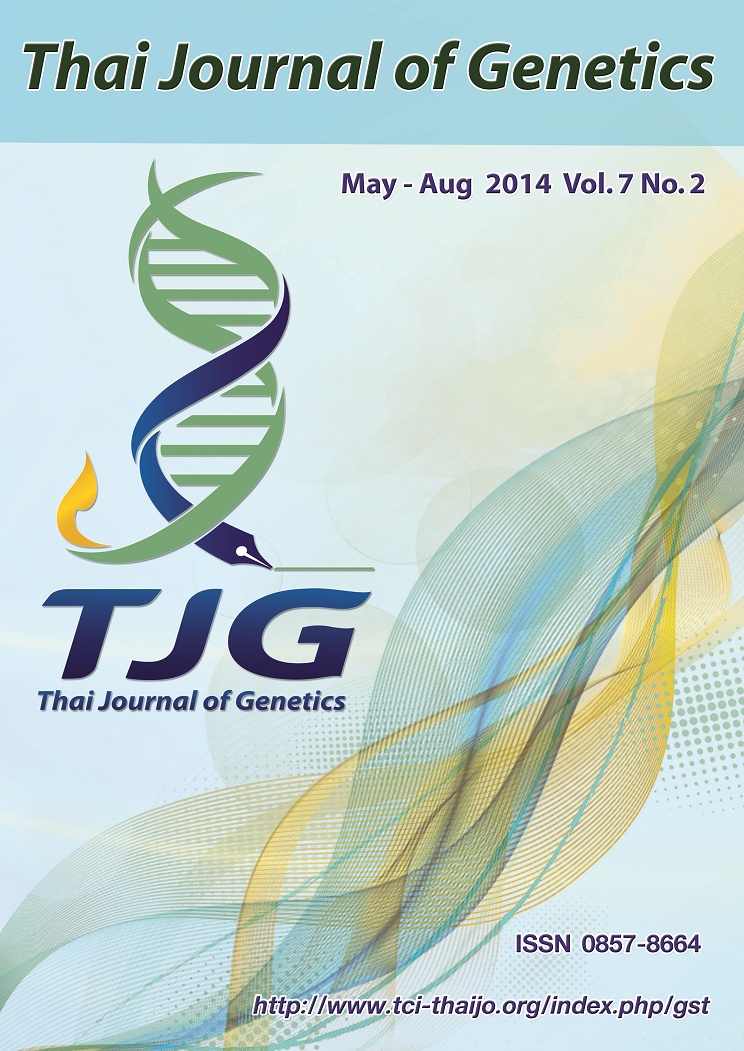การประยุกต์ใช้ดีเอ็นเอเครื่องหมายแบบ InDel markers เพื่อการจำแนกชนิดย่อย อินดิกา และจาปอนิกาในเชื้อพันธุ์ข้าวไทย (Application of InDel markers for subspecies indica-japonica rice classification in Thai rice germplasm)
DOI:
https://doi.org/10.14456/tjg.2014.1Keywords:
Asian cultivated rice, identification, subspecies, InDel DNA markerAbstract
ข้าวปลูกเอเชีย (Oryza sativa L.) จำแนกออกเป็นชนิดย่อยอินดิกาและจาปอนิกา ในการปรับปรุงพันธุกรรมข้าวโดยวิธีการผสมพันธุ์ นักปรับปรุงพันธุ์ต้องทราบถึงชนิดย่อยของเชื้อพันธุ์ข้าวที่ใช้ในการผสมพันธุ์การวิจัยนี้มีวัตถุประสงค์เพื่อประยุกต์ใช้เทคนิคการวิเคราะห์ดีเอ็นเอเครื่องหมาย InDel markers เพื่อจำแนกเชื้อพันธุ์ข้าวจำนวน 96 สายพันธุ์ และวิเคราะห์ความสัมพันธ์ทางพันธุกรรมหรือโครงสร้างทางพันธุกรรมของประชากรโดยใช้โปรแกรม STRUCTURE พบว่า ข้อมูลของเครื่องหมายดีเอ็นเอหรือ InDel fingerprint สามารถใช้ในการจำแนกพันธุ์ข้าวได้ในระดับชนิดย่อยได้โดยเปรียบเทียบกับพันธุ์ข้าวอ้างอิง และผลจากการวิเคราะห์ข้อมูล InDel fingerprint โดยโปรแกรม STRUCTURE เพื่อวิเคราะห์หาจำนวนประชากรย่อยที่เหมาะสมที่สุด (K) ของกลุ่มตัวอย่างข้าวที่ใช้ทดลอง พบว่าสายพันธุ์ข้าวที่ใช้ในการทดลองแบ่งออกเป็น 3 ประชากรย่อย (K=3) คือ สายพันธุ์กลุ่มอินดิกา กลุ่มจาปอนิกา และกลุ่มลูกผสมระหว่างสองชนิดย่อย
Asian cultivated rice (Oryza sativa L.) has been classified into indica and japonica subspecies. In rice breeding program, breeders need to know the subspecies (indica or japonica) of the parental lines used. In this study, Insertion/deletion (InDel) DNA markers was used to determine the indica and japonica subspecies of Thai rice germplasm. We analyzed a set of 96 rice accessions and STRUCTURE analysis was conducted to examine the genetic clusters and relationships of rice accessions, within an appropriate number of subpopulations (K-value). The results showed that InDel fingerprints can effectively determine the indica and japonica features of the rice germplasm when compared to the reference rice accessions both the indica and japonica types. STRUCTURE analysis clearly indicated that genetic differentiation of 96 rice accessions was assigned into three subpopulations (K=3), each subpopulation represented by three components, namely indica, japonica and hybrids which showed complex genetic constitution with combination of both indica and japonica.
References
Bellon MR, Brar DS, Lu BR, Pham JL (1998) Rice genetic resources. In: Dwoling NG, Greenfield SM, Fischer KS eds. Sustainability of rice in the global food system. Manila: The Pacific Basin Study Center and International Rice Research Institute (IRRI): 251–238.
Cai X, Liu J, Qiu Y, Zhao W, Song Z, Lu BR (2007) Differentiation of indica-japonica rice revealed by insertion/deletion (InDel) fragments obtained from the comparative genomic study of DNA sequences between 93–11 (indica) and Nipponbare (japonica). Front Biol China 2: 291–296.
Chang TT (1976) The origin, evolution, cultivation, dissemination, and diversification of Asian and African rices. Euphytica 25: 425–441.
Doyle JJ, Doyle JL (1987) A rapid DNA isolation procedure for small quantities of fresh leaf tissue. Phytochemical Bull 19: 11–15.
Lu BR, Snow AA (2005) Gene flow from genetically modified rice and its environmental consequences. Bioscience 55: 669–678.
Lu BR, Cai XX, Jin X (2009) Efficient indica and japonica rice identification based on the InDel molecular method: its implication in rice breeding and evolutionary research. Pro Nat Sci 19: 1241–1252.
Liu P, Cai XX, Lu BR (2012) Single-seeded InDel fingerprints in rice: an effective tool for indica-japonica rice classification and evolutionary studies. J Syst Evol 50: 1–11.
Oka HI, Chang WT (1963) A note on rice varieties of japonica type found in northern Thailand. Botanical Bulletin of Academia Sinica 4:163–168.
Prathepha P (2008) Analysis of plastid subtype ID sequences in traditional upland and lowland rice cultivars from Thailand. Asian J Plant Sci 7: 60–66.
Pritchard JK, Stephens M, Donnelly P (2000)
Inference of population structure using multilocus genotype data. Genetics 155: 945–959.
Shen YJ, Jiang H, Jin JP, Zhang ZB, Xi, He YY, Wang G, Wang C, Qian L, Li X, et al. (2004) Development Of genome-wide DNA polymorphism database for map-based cloning of rice genes. Plant Physiol 135: 1198–1205.
Vaughan DA, Lu BR, Tomooka N (2008) The evolving story of rice evolution. Plant Sci 174: 394–408.
Xiong Z, Zhang S, Wang Y, Ford-Lloyd BV, Tu M, Jin X, Wu Y, Yan H, Yang X, Liu P, Lu BR (2010) Differentiation and distribution of indica and japonica rice varieties along the altitude gradients in Yunnan province of China as revealed by InDel molecular markers. Genet Resour Crop Evol 57: 891–902.
Xu Q, Xu H, Wei X, Tang S, Lee D, Chen L (2012) SSILP, indel and SSR markers based indica and japonica classification for weedy rice. Chinese J Rice Sci 26: 686–692.
Yang C, Kawahara Y, Mizuno H, Wu J, Matsumoto T, Itoh T (2012) Independent domestication of Asian rice followed by gene flow from japonica to indica. Mol Biol Evol 29: 1471–1479.
Zhang Q, Maroof MAS, Lu TY, Shen BZ (1992) Genetic diversity and differentiation of indica and japonica rice detected by RFLP analysis. Theor Appl Genet 83: 495–499.
Zong Y, Chen Z, Innes JB, Chen C, Wang Z, Wang H (2007) Fire and flood management of coastal swamp enabled first rice paddy cultivation in east China. Nature 449: 459–462.



